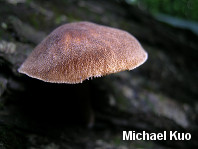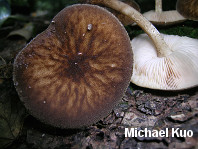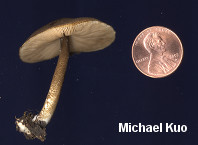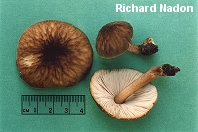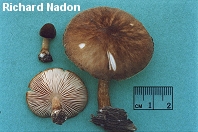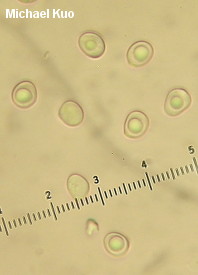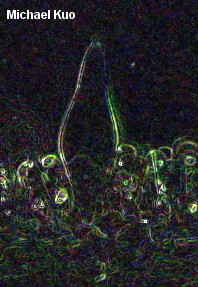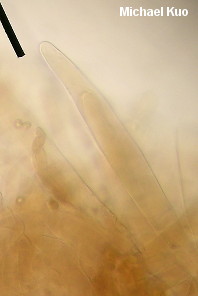| Major Groups > Gilled Mushrooms > Pink-Spored > Pluteus > Pluteus granularis |

|
Pluteus granularis [ Basidiomycota > Agaricales > Pluteaceae > Pluteus . . . ] by Michael Kuo When fresh this distinctive Pluteus species is covered with dark brown granules, making it fairly easy to recognize. Older specimens, however, are apt to have somewhat smoother caps and stems, folding them into the hordes of boring brown Pluteus species that usually require microscopic analysis for successful identification. Aside from the granulated surfaces, Pluteus granularis can be distinguished by its non-marginate gills (the edges of the gills, in other words, are colored like the faces), its medium size on the Pluteus ruler, and microscopic characters (see below). Description: Ecology: Saprobic on decaying wood of conifers or hardwoods; growing alone or scattered; summer and fall; common in the Great Lakes states and probably to be expected throughout eastern North America. The illustrated and described collections are from Illinois, Indiana, and Québec. Cap: 3-6 cm; convex at first, becoming broadly convex or nearly flat; densely covered with dark brown granules over a pale golden brown surface; sometimes becoming wrinkled, veined, or nearly reticulate over the center; in age often becoming somewhat smoother and less granulated; dry; the margin not lined. Gills: Free from the stem; close; whitish at first, becoming pinkish; the edges colored like the faces or very slightly brownish; short-gills frequent. Stem: 4-7 cm long; 2-5 mm thick; more or less equal above a slightly swollen base; whitish or pale brownish beneath darker brown granules arranged in stretched-out zones (especially near the base); basal mycelium white. Flesh: White; soft; unchanging when sliced. Odor and Taste: Somewhat radishlike. Chemical Reactions: KOH negative on cap surface. Spore Print: Pink. Microscopic Features: Spores 5-6.5 x 4.5-5 µ; broadly ellipsoid; smooth; hyaline and uni- to multiguttulate in KOH; inamyloid. Pleurocystidia up to 65 x 18 µ; widely lageniform; thin-walled; occasionally with a small apical projection. Cheilocystidia similar to pleurocystidia but smaller. Pileipellis a collapsing trichoderm; elements smooth, brown in KOH; terminal cells fusiform, with subacute apices, often aggregated into bundles. Clamp connections absent. REFERENCES: Peck, 1885. (Kauffman, 1918; Singer, 1956; Smith, Smith & Weber, 1979; McNeil, 2006; Kuo & Methven, 2014.) Herb. Kuo 09270506, 10011105. This site contains no information about the edibility or toxicity of mushrooms. |
© MushroomExpert.Com |
|
Cite this page as: Kuo, M. (2015, May). Pluteus granularis. Retrieved from the MushroomExpert.Com Web site: http://www.mushroomexpert.com/pluteus_granularis.html |
